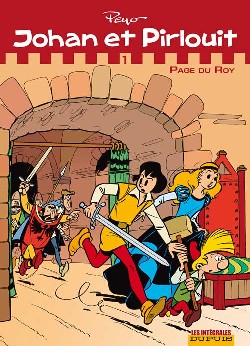- Comics
- Comics Reviews
- Manga
- Comics Reviews
- European Comics
- News
- Comics News
- Press Releases
- Columns
- Spotlight
- Digital Comics
- Webcomics
- Cult Favorite
- Back Issues
- Webcomics
- Movies
- Toys
- Store
- More
- About
By Patrick Bérubé
April 8, 2008 - 11:48
 |
The first is “Le châtiment de Basenhau”, in which we are introduced to Johan, the king’s page. In this initial story, Sir Basenhau is accused of treachery in a duel and is banished from the kingdom. Swearing vengeance, he vows to take the king down and rule in his place. Only the cunning of Johan can prevent his plan from succeeding. A siege on a castle, a villain, swordfights and a banquet make this one a classic.
The second adventure is quite different. In “Le maître de Roucybeuf”, Johan is a bit older and is investigating the disappearance of the king. At the same time, the heirs are targeted by a group of bandits. It look likes someone wants the throne, but who? This story is a lot more centered on mysteries than on action. Even if it still contains swordfights and pursuits, the contrast with the first adventure is interesting and refreshing.
The last story is considered by many, a new start for the series. It’s in “Le lutin du bois aux roches” that Johan first encountered his sidekick, Pirlouit. The title also changes, from there on, to Johan et Pirlouit, instead of just being Johan. The princess has been abducted and nobody knows why. Someone accuses a small boy, living by himself in the woods, of being the culprit and the chase is on. Uncertain of these accusations, Johan rescues Pirlouit only to learn that he could in no way be guilty and bands with him to rescue the princess. Epic fights ensue, armies clash, the damsel in distress is saved and Pirlouit is named…jester of the king.
This first volume also contains some very interesting bonus materials. We are shown some of Peyo’s first published strips as well as some sketches done in his early years. But the most interesting are the newspaper strips where Johan first appeared. Even if they are considered out of continuity, it really shows the character's evolution and how he came to be known today.
Peyo’s work in this collected edition is amazing. His approach to the visual aspect of the characters is simple but very effective. They are not encumbered with details, which gives them lot of fluidity and movement. His backgrounds are also kept simple, but are detailed enough to give them more realism. He also achieves something difficult when showings swordfights and combat. Done in a very cartoony way with a touch of humor, it makes this comic book very accessible to very young readers.
The stories, even if they are simple compared to modern standards, are still very acceptable. I will go as far as to say that’s what makes this comic book accessible and a classic. I had often read this title before but not these particular stories and I found myself having great fun. Some would argue that Johan's moral standard cannot be attained by any mortal being but that’s part of the naivety involved in this comic book.
I rate this comic book 9 out of 10 on the classic comic book scale. It should stand in any bookshelf right next to Tintin, Astérix and Lucky Luke (and the Smurfs of course)
Question? Comments? You would like to see a particular European comic book reviewed? You can reach me at pberube@comicbookbin.com